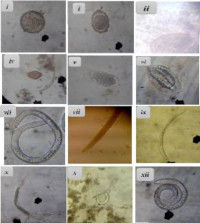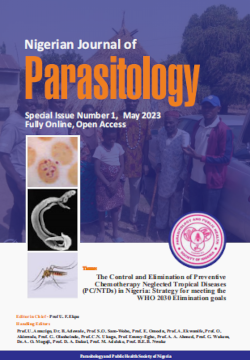Prevalence of soil-transmitted helminths’ ova in soil in Ibadan, Oyo State, Nigeria
http://dx.doi.org/10.4314/njpar.v40i2.11
Keywords:
Nigeria, Ibadan, prevalence, Soil-transmitted helminthsAbstract
Substantial Nigerian populace are at risk of soil-transmitted helminths such as Strongyloides stercoralis, Ascaris lumbricoides, Trichuris trichiura and hookworm. A study to enumerate soil-transmitted helminths (STHs) in Ibadan, Nigeria was conducted between September- December, 2017. Out of 150 soil samples examined with zinc sulphate concentration and formol ether sedimentation technique, 62% (95% CI: 53.7-69.8) were positive of STHs parasites. Strongyloides spp. was the most prevalence STH observed (30.0%) followed by Ascaris spp. (24.7%), with the least prevalence in Diphylidium caninum (0.6%). The parasitic ova intensity revealed that Strongyloides spp. showed significant increase (p<0.05) when compared with other parasitic ova in the locations. The highest mean parasite intensity was observed in Mokola, while the lowest was in Gege with no significant differences (p>0.05). Sources of soil sample revealed highest prevalence in dumpsite with a prevalence of 72.7% (95%CI: 54.5-86.7). The identified parasites from human and animal origin suggest environmental contamination. Enlightenment programmes on sanitation and hygiene, provisions of sanitary amenities are imperative to reduce the risk of epidemic outbreaks and zoonoses in humans and animals alike.
References
Chongsuvivatwong, V., Uga, S. and Nagnaen, W.1999. Soil contamination and infections by soil-transmitted helminths in an endemic village in southern Thailand.Southeast Asian Journal of Tropical Medicine and Public
Health, 30: 64-67.
Bethony, J., Brooker, S., Albonico, M., Geiger, S. M., Loukas, A., Diemert, D., Hotez, P. J. 2006. Soiltransmitted helminth infections: trichuriasis, and
ascariasis, hookworm. The Lancet, 367(9521): 1521-1532.
Hotez, P. J., Brindley, P. J., Bethony, J. M., King, C. H., Pearce, E. J. and Jacobson,J. 2008. Helminth Infections: The great neglected tropical diseases. Journal of Clinical Investigation, 118: 1311-1321.
Jourdan, P.M., Lamberton, P.H., Fenwick, A. and Addiss, D. G. 2017. Soil-transmitted helminth infections. The Lancet, 391(10117): 252-265.
Asaolu, S. O., Ofoezie, I. E., Odemuyiwa, P. A., Sowemimo, O. A. and Ogunniyi, T. A. B. 2002. Effect of water supply and sanitation on the prevalence and intensity of Ascaris lumbricoides among pre-school age
children in Ajebandele and Ifewara Osun State,Nigeria. Transactions of Royal Society of Tropical Medicine and Hygiene, 96: 600-604.
de Vlas, S. J., Stolk, W.A., le Rutte, E. A., Hontelez, J. A. C., Bakker, R., Blok, D. J., Cai, R., Houweling, T. A. J., Kulik, M. C., Lent, E. J., Luyendijk, M., Matthijsse, S. M., Redekop, W. K., Wagenaar, I., Jacobson, J., Nagelkerke, N. J. D. and Richardus, J. H. 2016. Concerted efforts to control or eliminate neglected tropical diseases: How much health will be gained? PLoS Neglected Tropical Diseases, 10: e0004386.
WHO. 2015. Investing to overcome the global impact of neglected tropical diseases. Third WHO report on neglected tropical diseases. Geneva: World Health Organization.
WHO. 2016. Summary of global update on preventive chemotherapy implementation in 2015. Weekly Epidemiology Record, 39: 456-59.
Ogbolu, D. O., Alli, O. A. T., Amoo, A. O.J., Olaosun, I. I., Ilozavbie, G. W. and Olusoga-Ogbolu, F. F. 2011. Highlevel parasitic contamination of soil sampled in Ibadan metropolis. African Journal of Medicine and Medical
Sciences, 40: 85-87.
Adekeye, T.A., Thompson, E. and Awobode, H. O. 2016. Environmental contamination and public health risk of soil parasites in Ibadan South East Local Government Area, Nigeria. Zoology and Ecology, 26(2): 150-157.
Adeyeba, O. A. and Tijani, B. D. 2002. Intestinal helminthiasis among malnourished school age children in peri-urban area of Ibadan, Nigeria. African Journal of Clinical Microbiology, 3: 24-28.
Nock, I. H., Duniya, N., Galadima, M. 2003. Geohelminth eggs in the soil and stool of pupils of some primary schools in Samaru, Zaria Nigeria. The
Nigerian Journal of Parasitology, 24: 115-122.
Cheesbrough, M. 2009. District laboratory practice in tropical countries. Part 1. 2nd ed. Cambridge: Cambridge University Press.
Dada, B. J. and Lindquist, W. D. 1979. Studies on flotation techniques for the recovery of helminth eggs from soil and the prevalence of Toxocara sp. in some Kanzas public places. Journal of the American Veterinary
Medical Association, 174: 1208-1210.
Dryden, M. W., Payne, P. A., Ridley, R. and Smith, V. 2005. Comparison of common faecal flotation techniques for the recovery of parasite eggs and oocysts. Veterinary Therapeutics, 6(1): 14-8.
Ukpai, O. M and Ugwu, C. O. 2003. The prevalence of gastro-intestinal tract parasites in primary school children in Ikwuano Local Government Area of Abia State, Nigeria. Nigerian Journal of Parasitology, 24:129-136.
Odu, N. N., Okonko, I. O. and Erhi, O. 2011. Study of neglected tropical diseases (NTds): Gastrointestinal helminthes among school children in Port Harcourt, Rivers State, Nigeria. Report and Opinion, 3(9): 6-16.
Hassan, A. A., Oyebamiji, D. A. and Idowu, O. F. 2017. Spatial patterns of soil transmitted helminths in soil environment around Ibadan, an endemic area in southwest Nigeria. Nigerian Journal of Parasitology, 38(2): 179-184.
Mohammed, F.I., Idris, U. D., Umoh, J. U., Ajanusi, O. J. and Abdullahi, J. 2011. The Prevalence of HELMINTH EGGS IN THE SOIL of Abuja Recreational Parks and Gardens, Abuja Nigeria. International Research Journal of Applied and Basic Sciences, 2(10): 398-403.
Odoba, M. B., Jr Otalu, O. and Balogun, J. B. 2011. Helminth parasite in primary schools in Zaria. World Journal Life Science and Medical Research, 2(5): 192-195.
Uga, S., Ono, K., Kataoka, N. and Hasan, H. 1996. Seroepidemiology of five major zoonotic parasite infections in inhabitants of Sidoarjo, East Java,
Indonesia. Southeast Asian Journal of Tropical Medicine and Public Health, 27: 556-561.
Ulukanligil, M., Seyrek, A., Aslan, G., Ozbilge, H. and Atay, S. 2001. Environmental pollution with soiltransmitted helminths in Sanliurfa, Turkey. Memorias do Instituto Oswaldo Cruz, 96(7): 903-909.
Nwoke, E. U., Ibiam, G. A., Odikamnoro, O. O., Umah, O. V.,Ariom, O. T. and Orji, I. 2013. Examination of soil samples for the incidence of geohelminth parasites in Ebonyi, north-central area of Ebonyi State, south-east of Nigeria. Archives of Applied Science Research, 5(6): 41-48.
Idahosa, O. T. 2011. Parasitic contamination of fresh vegetables sold in Jos markets. Global Journal of Medical Research, 11: 20-25.
Nkouayep, V. R., Ngatou, T. B. and Wabo P. J. 2017. Profile of geohelminth eggs, cysts, and oocysts of protozoans contaminating the soils of ten primary schools in Dschang, West Cameroon. Journal of Parasitology Research, doi:10.1155/2017/1534675.
Brooker, S., Hotez, P. J. and Bundy, D. A. 2008. Hookworm-related anaemia among pregnant women: a systematic review. PLoS Neglected Tropical Diseases, 2: e291.
Lal,C., Huggins,J. T.,Sahn, S. A. 2013. Parasitic diseasesof the pleura. American Journal of Medical Sciences, 345: 385-389.
Das, A. K. 2014. Hepatic and biliary ascariasis. Journal of Global Infectious Diseases, 6: 65-72.
Wokem, G. N. and Onosakpondme, E. O. 2014. Soiltransmitted helminthiasis in Sapele local government, Delta State, Nigeria. Nigerian Journal of Parasitology, 35(1-2): 143-148
Weaver, H. J., Hawdon, J. M. and Hoberg, E. P. 2010. Soil-transmitted helminthiases: implications of climate change and human behavior. Trends in parasitology, 26(12): 574-581
Brooker, S., Clements, A. and Bundy, D. A. P. 2006. Global epidemiology, ecology and control of soiltransmitted helminth infections. Advances in
Parasitology, 62: 223-265.
Tavalla, M., Oormazdi, H., Akhlaghi, L., Razmjou, E., MoradiLakeh, M., Shojaee, S., Hadighi, R. and Meamar, A. 2012. Prevalence of parasites in soil samples in Tehran public places. African Journal of Biotechnology, 11(20): 4575-4578.
Ademola, I. O., Krucken, J., Ramunke, S., Demeler, J. and von Samson-Himmelstjerna, G. 2015. Absence of detectable benzimidazole-resistance associated alleles in Haemonchus placei in cattle in Nigeria revealed by
pyrosequencing of Ñ-tubulin isotype 1. Parasitology Research, 114(5): 1997-2000.
Ukwubile, C. A., Otalu-Jr, O., Akpabio, U. and Agu, M. O. 2013. The prevalence of parasitic human intestinal helminthes and the efficacy of anthelmintic drug in children in Uzo-Uwani Local Government Area. Enugu
State, Nigeria. Open Journal of Medical Microbiology, 3: 213-218.
Odeniran, P.O. and Ademola, I. O. 2013. Prevalence of zoonotic gastrointestinal helminth in dogs and knowledge of risk of infection by dog owners in Ibadan, Nigeria. Nigerian Veterinary Journal, 34(3): 851-858.

Downloads
Published
How to Cite
Issue
Section
License
Copyright (c) 2023 Nigerian Journal of Parasitology

This work is licensed under a Creative Commons Attribution-NonCommercial-NoDerivatives 4.0 International License.




